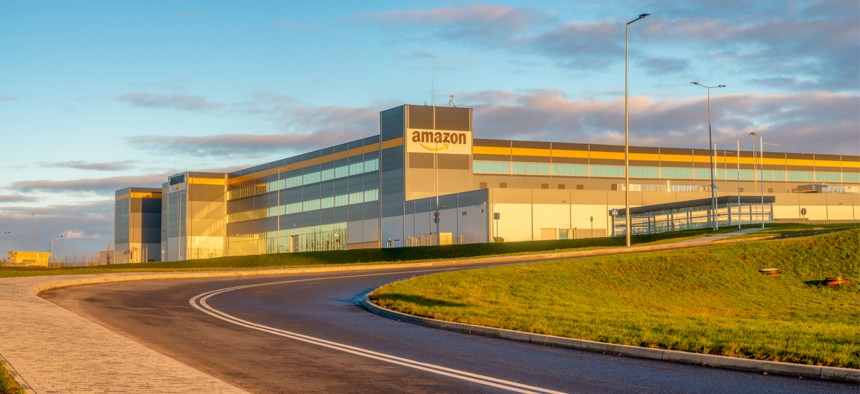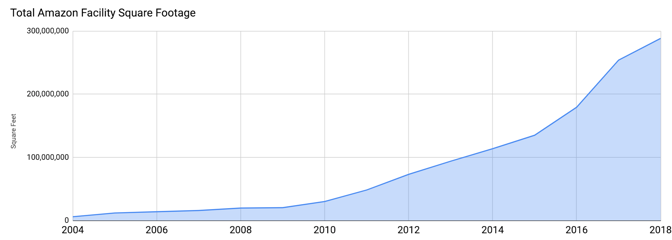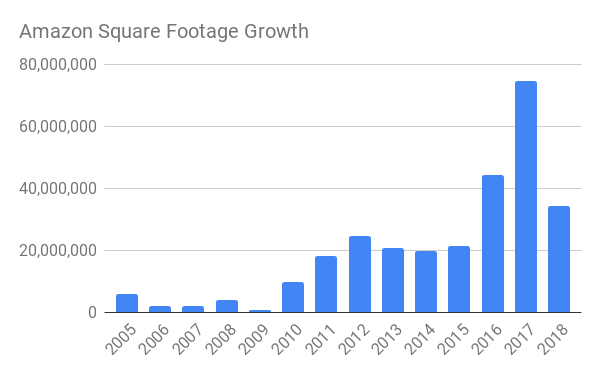When Amazon Went From Big to Unbelievably Big

An Amazon logistics center in Poland. Mike Mareen/Shutterstock.com
The data on the company’s real-estate holdings reveal a remarkable inflection point.
Amazon’s origin story is firmly embedded in the chunky-sweatered dorkiness of the late-1990s dot-com boom.
But the Amazon of today—the dominant, ubiquitous retailer of everything—is a much, much newer creation. The past three years have seen a new Amazon emerge as the company’s physical footprint balloons.
According to its latest annual report, Amazon now has 288 million square feet of warehouses, offices, retail stores, and data centers. In 2017—the biggest growth year for the company’s properties—alone, it added more square feet of building (74.6 million) than the company had total in 2012 (73.1 million), when it was already the largest online retailer in the world. Amazon has added more building space from 2016 to 2018 as it did in all the rest of its history. Go back a little further in time, and the growth is even more astounding: Amazon has 48 times the square footage it did in 2004.


This is not due to the growth of Amazon Web Services (the company’s data-center business), or the acquisition of Whole Foods. All of its retail locations add up to less than 20 million square feet; the whole Amazon Web Services business occupies only 10 million square feet. Amazon’s recent growth has been in the service of logistics, the work of getting stuff you order on the internet to your home or business.
It’s hard to comprehend how huge Amazon’s holdings are now. But consider: The biggest casino in Las Vegas (that’d be the Wynn and Encore complex) is 186,000 square feet, which is less than .06 percent of the size of Amazon’s real-estate holdings. The biggest Walmart Supercenteranyone’s ever seen is roughly 260,000 square feet; Amazon has added facilities equivalent to 590 of that store in the past three years.
These numbers show that Amazon hit a major inflection point in 2016—22 years after the company was founded, nine years after the introduction of Amazon Prime.
Everything that the company did up to that point has been dwarfed by its new growth. For example, Amazon had almost $100 billion more revenue in 2018 ($233 billion) than it did in 2016 ($136 billion). The big tech companies—Microsoft, Google, Facebook, Apple, and Amazon—have become so large that even relatively modest percentage growth in any of their businesses would translate into enormous absolute change in the world.
At a site visit I took with one of Amazon’s major warehouse developers—Prologis—one employee pointed at a huge building under construction and noted a crucial change in the American economy: “People don’t realize this is where the future is,” he said. “No one’s going to shopping malls. Shopping malls are going into here, right?”
That change ripples out into the labor markets. As Amazon grows, it has to hire new employees by the tens of thousands. Many exurbs have been eager to capture this job growth, even if the wages of those jobs remain low.
Companies this big, that create such huge economies around themselves, are difficult to describe. What do you call the megacorp that becomes … that much more mega?



